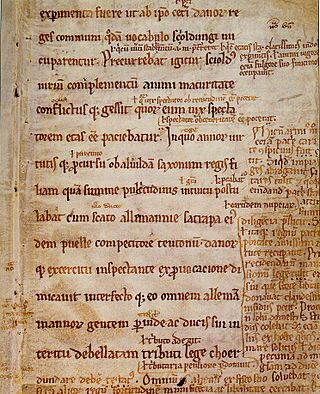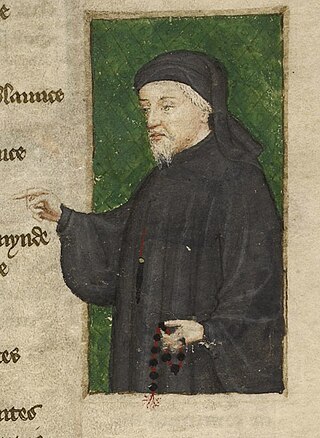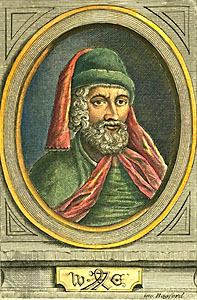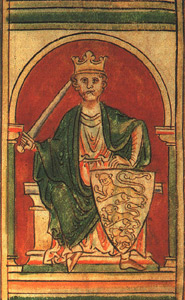Related Research Articles

Gesta Danorum is a patriotic work of Danish history, by the 12th-century author Saxo Grammaticus. It is the most ambitious literary undertaking of medieval Denmark and is an essential source for the nation's early history. It is also one of the oldest known written documents about the history of Estonia and Latvia.

Geoffrey Chaucer was an English poet, author, and civil servant best known for The Canterbury Tales. He has been called the "father of English literature", or, alternatively, the "father of English poetry". He was the first writer to be buried in what has since come to be called Poets' Corner, in Westminster Abbey. Chaucer also gained fame as a philosopher and astronomer, composing the scientific A Treatise on the Astrolabe for his 10-year-old son Lewis. He maintained a career in the civil service as a bureaucrat, courtier, diplomat, and member of parliament.

William Caxton was an English merchant, diplomat and writer. He is thought to be the first person to introduce a printing press into England in 1476, and as a printer to be the first English retailer of printed books.
Gaius Julius Hyginus was a Latin author, a pupil of the scholar Alexander Polyhistor, and a freedman of Caesar Augustus. He was elected superintendent of the Palatine library by Augustus according to Suetonius' De Grammaticis, 20. It is not clear whether Hyginus was a native of the Iberian Peninsula or of Alexandria.

Wynkyn de Worde was a printer and publisher in London known for his work with William Caxton, and is recognised as the first to popularise the products of the printing press in England.
Juliana Berners, O.S.B.,, was an English writer on heraldry, hawking and hunting, and is said to have been prioress of the St Mary of Sopwell, near St Albans in Hertfordshire.

Thomas Hoccleve or Occleve (1368/69–1426) was a key figure in 15th-century Middle English literature, significant for promoting Chaucer as "the father of English literature", and as a poet in his own right. His poetry, especially his longest work, the didactic work Regement of Princes, was extremely popular in the fifteenth century, but went largely ignored until the late twentieth century, when it was re-examined by scholars, particularly John Burrow. Today he is most well known for his Series, which includes the earliest autobiographical description of mental illness in English, and for his extensive scribal activity. Three holographs of his poetry have survived, and he also copied literary manuscripts by other writers. As a clerk of the Office of the Privy Seal, he wrote hundreds of documents in French and Latin.
Robert Whittington was an English grammarian. He was a pupil at Magdalen College School, Oxford, where he probably studied under the grammarian John Stanbridge.

The Seven Wise Masters is a cycle of stories of Sanskrit, Persian or Hebrew origins.
Apollonius of Tyre is the hero of a short ancient novel, popular in the Middle Ages. Existing in numerous forms in many languages, all are thought to derive from an ancient Greek version now lost.

Richard Pynson was one of the first printers of English books. Born in Normandy, he moved to London, where he became one of the leading printers of the generation following William Caxton. His books were printed to a high standard of craftsmanship, and his Morton Missal (1500) is regarded as among the finest books printed in England in the period.
Walter Hilton, Can. Reg. was an English Augustinian mystic, whose works gained influence in 15th-century England and Wales. He is commemorated by the Church of England and by the Episcopal Church in the United States.

Dicts and Sayings of the Philosophers is an incunabulum, or early printed book. The Middle English work is a translation, by Anthony Woodville, of a wisdom literature compendium written in Arabic by the medieval Arab scholar al-Mubashshir ibn Fatik, titled Mukhtār al-ḥikam wa-maḥāsin al-kalim which had been translated into several languages. Woodville based his version on an earlier French translation. His translation would come to be printed by William Caxton in 1477 as either the first, or one of the earliest, books printed in the English language.

The Decameron, subtitled Prince Galehaut and sometimes nicknamed l'Umana commedia, is a collection of short stories by the 14th-century Italian author Giovanni Boccaccio (1313–1375). The book is structured as a frame story containing 100 tales told by a group of seven young women and three young men; they shelter in a secluded villa just outside Florence in order to escape the Black Death, which was afflicting the city. Boccaccio probably conceived of the Decameron after the epidemic of 1348, and completed it by 1353. The various tales of love in The Decameron range from the erotic to the tragic. Tales of wit, practical jokes, and life lessons contribute to the mosaic. In addition to its literary value and widespread influence, it provides a document of life at the time. Written in the vernacular of the Florentine language, it is considered a masterpiece of early Italian prose.
Nationality words link to articles with information on the nation's poetry or literature.
Andrew Chertsey was an English translator, now known for the devotional collection The craft to lyve well and to dye.
Richard Whitford was a 16th century English Catholic priest known as an author of many devotional works.

Beves of Hamtoun, also known as Beves of Hampton, Bevis of Hampton or Sir Beues of Hamtoun, is an anonymous Middle English romance of 4620 lines, dating from around the year 1300, which relates the adventures of the English hero Beves in his own country and in the Near East. It is often classified as a Matter of England romance. It is a paraphrase or loose translation of the Anglo-Norman romance Boeuve de Haumton, and belongs to a large family of romances in many languages, including Welsh, Russian and even Yiddish versions, all dealing with the same hero.

Richard Coer de Lyon is a Middle English romance which gives a fictionalised account of the life of Richard I, King of England, concentrating on his crusading exploits. It influenced Shakespeare's King John and Walter Scott's The Talisman.
References
- 1 2 3 4 5 6 7 Chisholm 1911.
- ↑ Margaret Schlauch (1969). Chaucer's Constance and Accused Queens. New York: Gordian Press. p. 111.
- ↑ D. L. Ashliman, Of Women, Who Not Only Betray Secrets, but Lie Fearfully
- ↑ Blamires, David. "Folktales and Fairytales in the Middle Ages". In: Bulletin of the John Rylands University Library of Manchester 74 (1992): 102-103.
- ↑ Laura A. Hibbard (1963). Medieval Romance in England. New York: Burt Franklin. p. 3.
- ↑ "Gesta Romanorum". The Cambridge History of English and American Literature in 18 Volumes.
Printed first at Utrecht, then at Cologne, c. 1472–5. First English edition printed by Wynkyn de Worde, c. 1510–15. For a full discussion of the different MSS. used, the sources of the groups, etc., see the indispensable edition of Oesterley, H., Berlin, 1872.
- 1 2 Charles Swan (1905). Wynnard Hooper (ed.). Gesta Romanorum. London: George Bell & Sons. (at Wikisource)
- ↑ "'Gesta Romanorum', - National Library of Wales Archives and Manuscripts". archives.library.wales. Retrieved 2021-09-09.
- ↑ Keller, H. Adelbert von (1842). Gesta Romanorum. Harvard University. Stuttgart, Tübingen, J.G. Cotta.
- ↑ Oesterley, Hermann (1872). Gesta Romanorum;. Robarts - University of Toronto. Berlin, Weidmann.